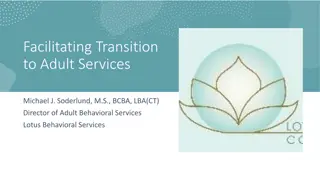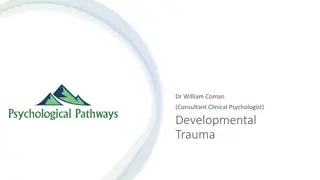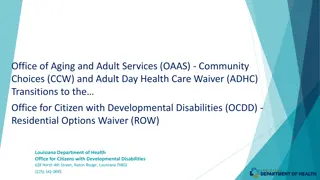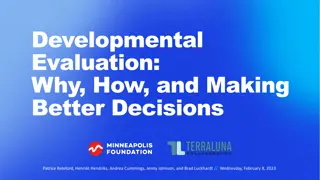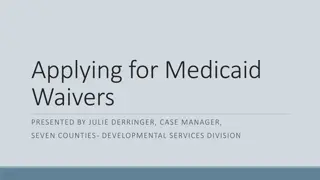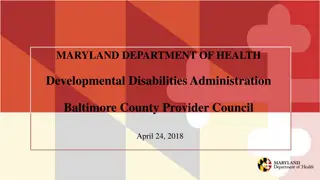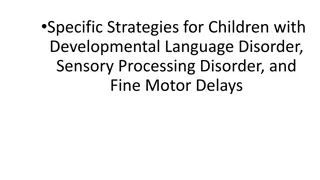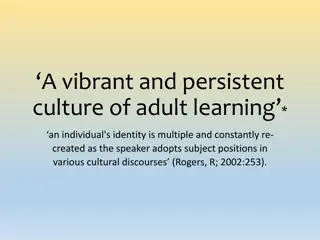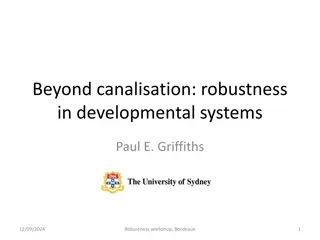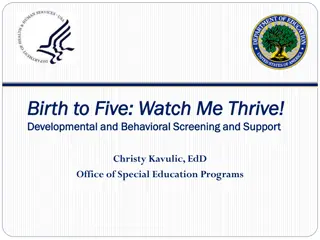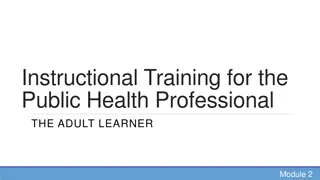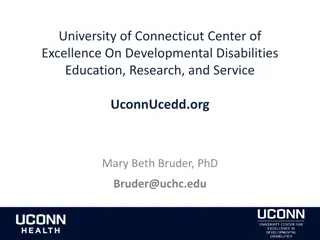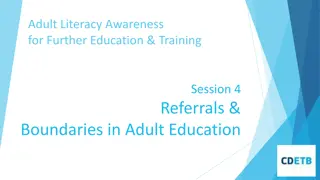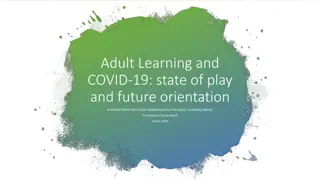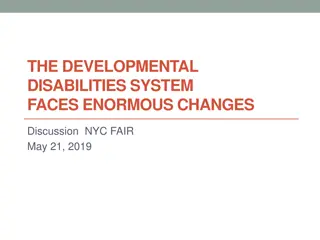Adult Developmental Services
Maine's adult developmental services system has historical roots in group homes developed in the 1980s. Despite changing needs, the system heavily invests in structured group homes. The strategy aims to enhance family supports, expand supported living options, promote self-directed options, comply with regulations, redesign crisis services, and utilize technology for inclusion.
Download Presentation

Please find below an Image/Link to download the presentation.
The content on the website is provided AS IS for your information and personal use only. It may not be sold, licensed, or shared on other websites without obtaining consent from the author.If you encounter any issues during the download, it is possible that the publisher has removed the file from their server.
You are allowed to download the files provided on this website for personal or commercial use, subject to the condition that they are used lawfully. All files are the property of their respective owners.
The content on the website is provided AS IS for your information and personal use only. It may not be sold, licensed, or shared on other websites without obtaining consent from the author.
E N D
Presentation Transcript
1 Adult Developmental Services Strategy for Serving More People with Responsive and Inclusive Services Discussion Draft 11/18/19
Historical Roots of Current Residential Services 2 Maine s system of developmental services for adults relies heavily on group homes developed in the 1980s and 90s to meet terms of the Pineland Consent Decree. Most people served by the system today never experienced Pineland, having grown up with their families and attended public schools. Despite changing needs, expectations, and best practices, the system continues to invest most heavily in highly structured group homes. A more flexible array of cost-effective services that can change over the lifespan could be more responsive to individual needs over time and enable more people to be served.
3 Residential Setting of Section 21 and 29 Participants, SFY 2019 Other Residential 6% Home Support 27% Group Home 41% Shared Living 26%
Maine Relative to NE and US Support of Families Percent of Total Statewide IDD Caregiving Families Supported by State IDD Agencies, 2015 Fiscal Effort Nationally, Maine is second only to NY State s spending for IDD services per $1,000 of total statewide personal income, 2015 35.0% $10.00 $9.26 31.2% 30.0% $9.00 30.0% $8.00 25.0% 23.0% $6.53 $7.00 $5.78 $6.00 $5.25 20.0% $5.00 $4.50 14.7%15.4% $4.32 $3.96 15.0% 13.1% $4.00 11.1% $3.00 10.0% $2.00 5.0% $1.00 1.6% $0.00 0.0% 4 Source: The State of the States in Intellectual and Developmental Disabilities www.stateofthestates.org
Section 21 / 29 Services Section 21 Services: Served: Total Wait List: Unduplicated Wait List: Percent with Other Services: 68% Ratio: Served to No Services: 6:1 Section 29 Services: Served: Total Wait List: Unduplicated Wait List: Percent with Other Services: 41% Ratio: Served to No Services: 12:1 3,186 1,639 529 2,286 323 189 Section 21 Waitlist by Age Section 29 Waitlist by Age 140 40 35 120 30 100 Members 25 80 Members 20 60 15 40 10 20 5 0 0 18 21 24 27 30 33 36 39 42 45 48 51 54 57 60 63 66 69 72 75 78 81 84 87 90 Age 18 21 24 27 30 33 36 39 42 45 48 51 54 57 60 63 66 69 72 75 78 81 84 87 90 Age 5
6 Direction: Community 2.0 PRIMARY DRIVERS SECONDARY DRIVERS AIM Enhance family supports: respite, behavioral/crisis support, networking Enhance supported living: more options, training, behavioral/crisis support Make information and options easier for families to find Add self-directed option for greater flexibility Comply with CMS HCBS Settings Rule to ensure inclusion in all settings* Redesign Crisis Services to emphasize primary and secondary prevention* Expand inclusion-enhancing technology Expand quality assurance and improvement efforts* Maine will enhance and expand flexible and responsive supports to individuals and families, balancing the group home model with other models. This will result in a more adaptable, affordable, inclusive, and fair system of supports, and enable more people to be served. 1. Enhance High Quality Inclusive Options 2. Reinvigorate Person- Centered Thinking Adopt Charting the Lifecourse Framework Protect and strengthen natural supports Emphasize Employment First Strengthen self-advocacy* Implement conflict-free, person-centered needs assessment Consider a single, flexible lifespan waiver 3. Develop Alternative Payment Models (APMs) Improve quality measurement infrastructure Introduce alternative payment models to incentivize desired system outcomes (e.g., tie portion of behavioral payment to reduction in admissions; tie portion of employment-related payments to employment outcomes) *underway
7 Next Steps Continue to serve Priority 1 applicants under Section 21. Continue to offer the new Section 21 opportunities funded in the current budget (167 new opportunities), as well as Section 29 opportunities that become available as people move from 29 to 21. As new resources become available, fund additional opportunities in Section 29. Discuss ideas with stakeholder groups to further develop and prioritize them for implementation over time.



